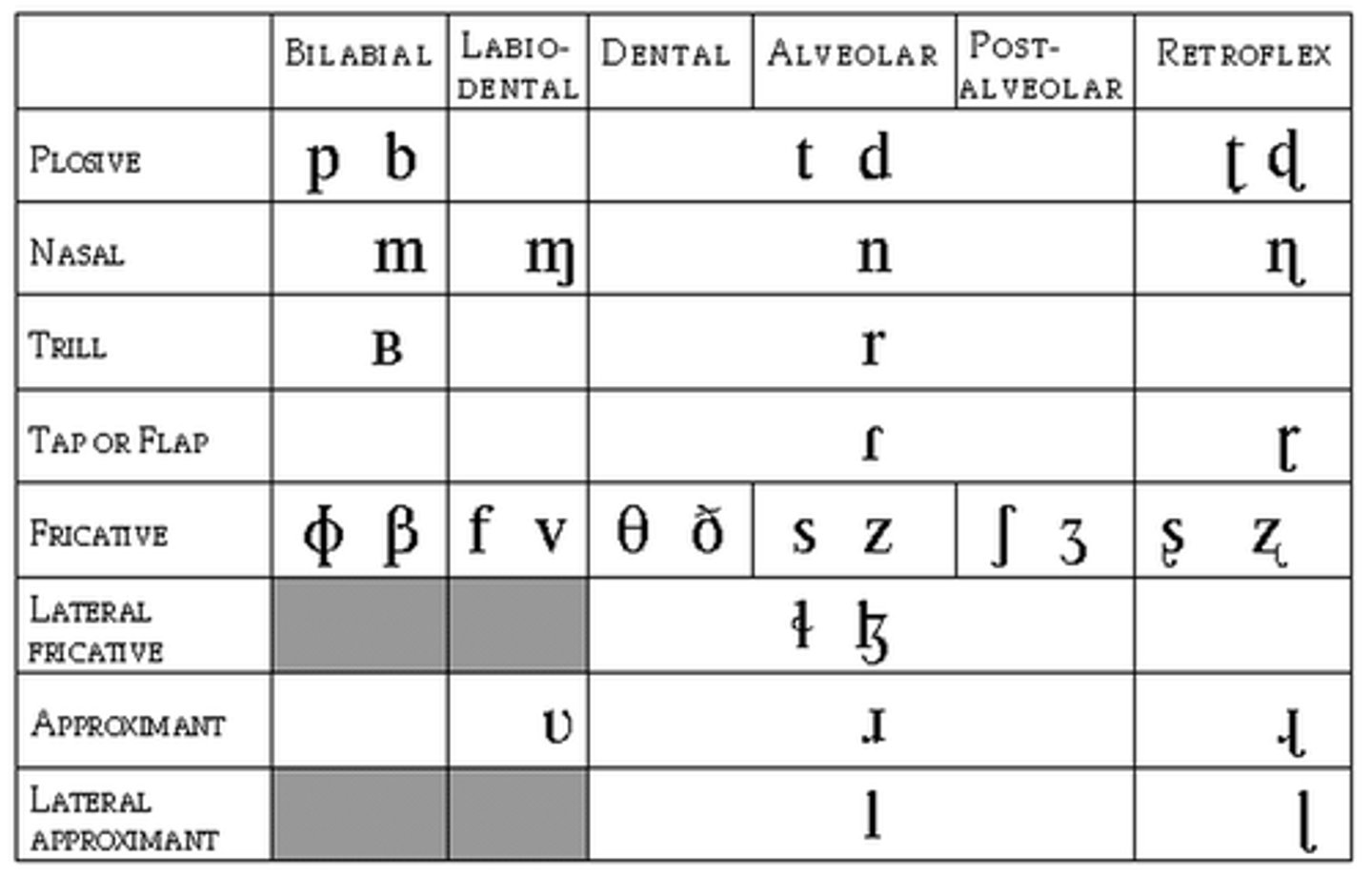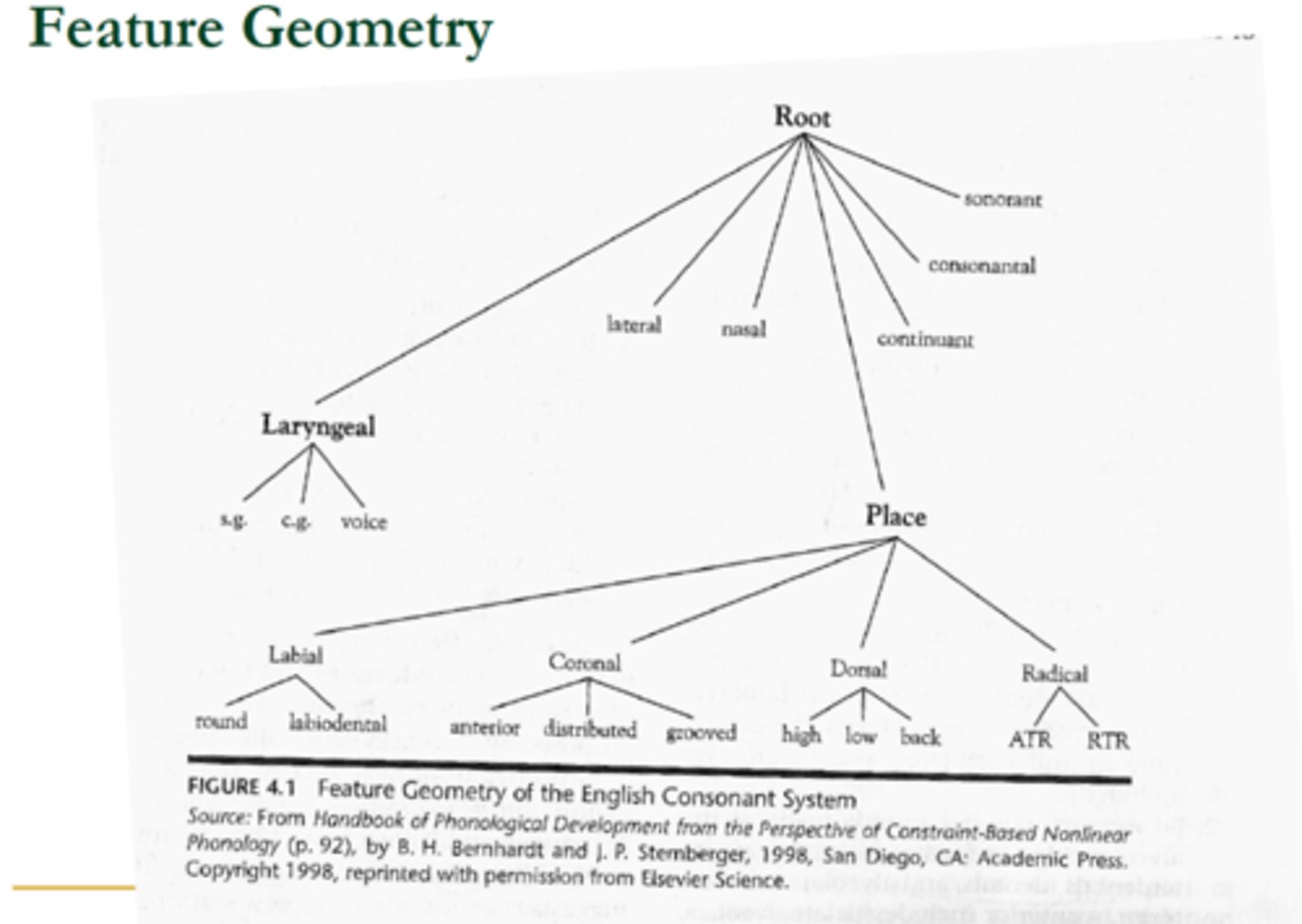Phonology 1
1/46
There's no tags or description
Looks like no tags are added yet.
Name | Mastery | Learn | Test | Matching | Spaced |
|---|
No study sessions yet.
47 Terms
sonority scale
from highest to lowest: V G L N O
feature values that divide each member:
V: +syllabic
G: -consonantal -syllabic
L: +consonantal +aproximant
N: -approximant +sonorant
O: -sonorant
feature values per each member:
V: +syll, -cons, +approx, +son
G: -syll, -cons, +approx, +son
L: -syll, +cons, +approx, +son
N: -syll, +cons, -approx, +son
O: -syll, +cons, -approx, -son
phonological processes
assimilation: _ -> palatalized...etc / _
deletion: _ -> null
insertion: null -> _
phonology in allomorphy
relates to how words can be made up of sounds that distinguish the meaning, and how different sounds can create different meanings in words
process of solving morphophonology problems
1. identify morphological structure
2. identify alternation
3. create hypotheses
4. figure out which hypothesis is correct, write a rule
5. name the rule
6. figure out URs
7. derivation chart
Chomsky's hierarchy of levels of adequacy
observational: accounts for all known data, limited to what is given in the data set (which segments occur in which environments)
descriptive: corresponds to a native speakers' knowledge; captures a psychological generalization (voiceless -> voiced / palatals)
explanatory: explains speakers competence at an underlying level, considers universal language grammar conditions (asks WHY the alternations happen using morphophonology)
vowel chart

IPA chart
MoA:
plosives: Put Back The Dishes Keep Going Glottal
nasal stops: Me No Ng
fricatives: Fav Version Says Zing x Hi +special characters
affricates: Cha Ja
approximants: Wa La Ra Ja
flaps: flap
PoA:
bilabial: BiPaMial
labiodental: FaViodental
labiovelar: Wabialvelar
alveolar: ToDay Not Saying ZiLChaJa, Ratatata (all six special characters
palatal: palaJal
velar: KeGNyarXY
glottal: h, glottal

features
determine which contrasts are possible in a language, and which set of phonemes are possible.
distinctive features distinguish a group of phonemes in a language from the others in its inventory, redundant features do not.
contrast in phonology
differences in sounds that change how that sound is perceived
similarity
allophones are similar to phonemes, closest sound in a language is used in loanwords, rhyming words are very similar. these segments share phonetic features are are often found as variants of the same underlying phoneme
neutralization
if phonemes share an allophone in the same environment, the contrast is not used to differentiate meaning
cross-linguistic syllabification process
division of words into syllables, most languages prefer maximizing the onset and avoiding codas, assigning syllables from left to right.
1: transcribe into IPA
2: identify nuclei
3: attach segments to the left as onsets (maximum onset principle)
4: any segments left are attached as codas
sonority sequencing principle
sounds preceding the nucleus (i.e. onsets) must rise in sonority, and sounds following the nucleus (i.e. codas) must fall in sonority
syllable contact law
cross-linguistically, syllable boundaries that cause a sonority decrease from coda to onset are preferred
syllable weight
heavy (H) vs. light (L), onset does not contribute to weight, it is only the content of the rhyme.
CV = light
CVV = heavy
CVC = heavy
rhyme
rhyme is a gradient scale, going from perfect rhyme, imperfect rhyme, and non-rhyme. there are two types of imperfect rhyme:
subsequence rhyme: segments in one corresponding string are a subset of the segments in the other string. (ex. sALt vs. ALl). we use an X to denote subsequence rhyme, so the notation for this example would be: [Xt]-[Xl]. slant, imperfect, and half rhyme are all synonyms of this type.
feature rhyme: some corresponding segments differ in feature values (ex. jʌŋ vs. ɹʌn where the ŋ and n differ slightly in features)
meter
rhythmic structure of lines of poetry, measured in feet. heavy and light syllables or stressed and unstressed syllables are marked with macron and breve symbols.
stress and phonetic cues
in english, stress cues include higher pitch, longer and louder vowels, presence of full set of vowels, and voiceless plosives becoming aspirated.
phonemic stress: contrastive, stress is used to distinguish words (ex. record and record)
phonologic stress: non-contrastive, can write rules because stress is governed by phonological rules
stress languages are culminative, and have one primary stress per word, but can have multiple unstressed or secondary stressed syllables.
mora and prosodic hierarchy
mora essentially represent duration, and it is something in which a long syllable consists of two and a short syllable consists of one. from top to bottom, the hierarchy reads:
prosodic word
foot
syllable
mora
tone systems
tone languages use pitch to distinguish words, and each syllable corresponds to a pitch. pitch is relative, controlled by a frequency of vocal chord vibration.
simple tone system: 2 tones (H L) or 3 tones (H M L)
complex tone system: includes level tones (H M L) and contour tones (rising and falling)
TBUs are assigned one-to-one, left to right
well-formedness convention
three principles that must be followed for the association of a TBU to be proper:
every tone must match with at least one TBU
every time we have a TBU, it must be associated with a tone
association lines may not cross
tone processes
twin sister convention: identical adjacent tones associated to one TBU are automatically simplified to a single tone
tone preservation: when we delete a vowel, this does not result in the deletion of the associated tone
tone shifting: tone is delinked and then associated to the next TBU
tone spreading: tone associated to an additional TBU
delinking: the association line between a tone and a TBU is severed
solid lines show the tone existing at the time of the process, dotted lines show the result of the process and the new things that are occurring, and removed association lines are marked with = or x.
approaches to high and low tones
H tones are treated as underlying, however there are two approaches to analyzing L tones:
L is also underlying
or, L is inserted at the end of the derivation. any TBU that doesn't have an associated tone receives an L tone after all rules are applied
for the second approach, you must state at the end of the derivation chart "default L association," which can be iterative.
obligatory contour principle (OCP)
prohibition against 2 identical adjacent tones in a morpheme's UR. this is caused by the same rule governing stress clashes as it makes the tone less prominent and identifiable.
linear and non-linear phonology
linear: features exist on one line
non-linear: tone, stress, timing, and segmental features all have separate tiers
feature geometry
theory that features exist in a structured hierarchy on autosegmental tiers (rather than as a bundle)
this only includes features in their + values, and they are used as instructions to articulators to perform tasks
there are features tied to a particular articulator, and stricture features

bottlebrush model
every feature is connected to the timing tier, but independently branches off. place features seem to be connected to each other, and this theory does not account for both this and the fact that nasal place assimilation exists.
rule based analysis
focuses on getting from an input to an output, rewriting derivations from one sequence to another
main skepticalities are what constrains the possible rules, and if unnatural rules are possible, and also the connection between two rules that describe the same target are not always specified.
optimality theory (OT)
linguistic model that proposes language forms are created through satisfying viable constraints as opposed to rules.
viable constraints are interacting principles that match the typology of the given language
the change from input to output is a competition between processes
OT model
lexicon: contains the URs of morphemes
CON: constraint set; set of universal constraints
GEN: generator; takes a word's UR as input and produces an infinite set of outcomes
EVAL: evaluator; evaluates each potential output using the language-specific constraints and determines winners
constructing tableaux
the first constraint listed will be whichever is the most dominant
-fatal candidates are marked with !
-candidates that win are marked with the wingding hand
-candidates that "win" but do not produce the correct surface form are marked with a bomb
if there are two predicted winners, another constraint is needed
faithfulness constraints
match the input and want things to stay the same, penalizes changes such as
-insertion
-deletion
-changes to feature values
-changes in order of segments
-assimilation
MAX-IO
maximality from input -> output, penalizes deletion
"assign a violation for each segment in the input that does not have a correspondence in the output"
DEP-IO
dependence from input -> output, penalizes insertion
"assign a violation for each segment in the output that does not have a correspondence in the input"
IDENT-IO(feature)
"assign a violation for any segment in the output that does not have identical values for the specified feature in the input"
markedness constraints
penalize marked output configurations; don't have to match the input but consider universal qualities considered "rule violations"
-rare vs. common universal language traits
-harder vs. easier articulation
-harder vs. easier to perceive
syllabification relies on markedness constraints as it is not included in the URs of morphemes
ONSET
*[sigmaV
"assign a violation for each syllable that has an onset"
NOCODA
*C]sigma
"assign a violation for each syllable with a coda"
*COMPLEX-ONSET
*[sigmaCC
"assign a violation for each syllable that has two or more segments in its onset"
*COMPLEX-CODA
*CCsigma]
"assign a violation for each syllable that has two or more segments in its coda"
*VOICEDCODA
"assign a violation for each voiced obstruent in coda position"
INTER-V-VOICE
"assign a violation for each intervocalic consonant that is not voiced"
(intervocalic = occurring between two vowels)
*VNASAL
"assign a violation for any vowel that is nasal"
*VORALN
"assign a violation for any oral vowel occurring before a tautosyllabic nasal"
(tautosyllabic = in the same syllable)
open vs. closed syllables
open syllables do not include codas, whereas closed syllables do
proposing constraints
every constraint must be proposed in a pair, and must be universal. each constraint should have a definition stating how to assign a violation.
you should also produce descriptive generalizations based on the data, but be sure they are NOT language specific and keep universal typology in mind.
factorial typologies
if we have 3 constraints, 3! = 6, and therefore we should find 6 possible rankings to predict the language's behavior
all constraints should be universal, and therefore this example would predict every language in the world would have one of these 6 possible rankings.
in other words, the number of constraints in its factorial form makes up the number of possible rankings.